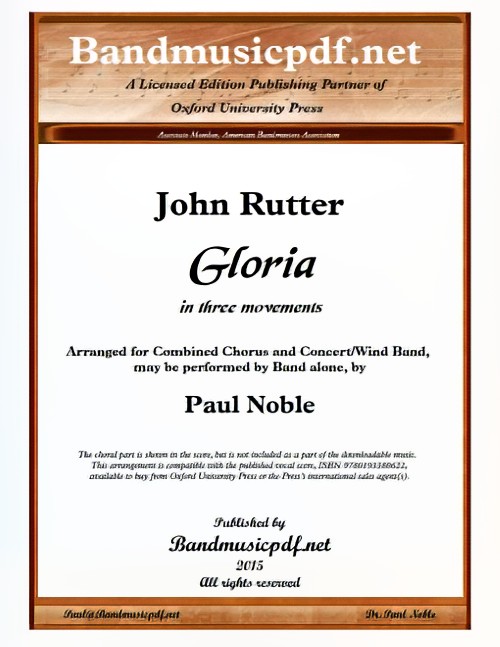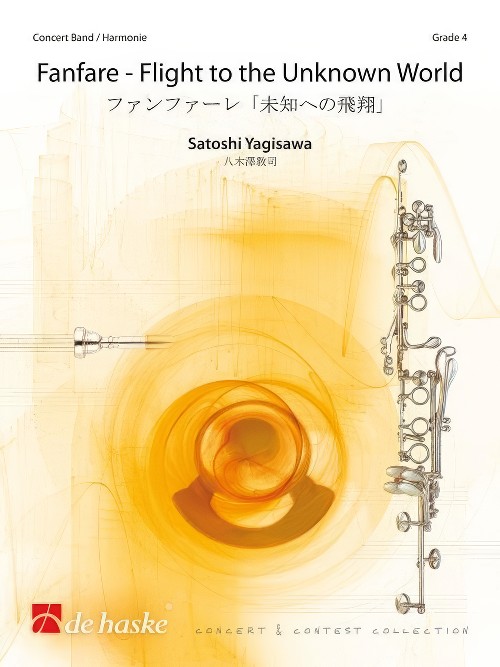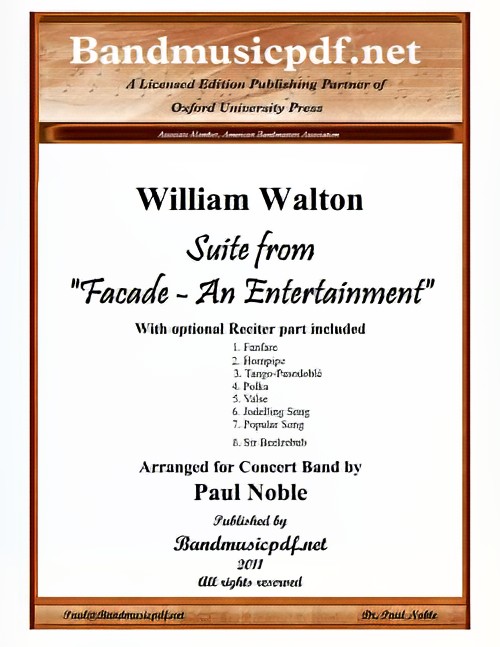Results
-
 £110.00
£110.00Gloria, Movement II (Concert Band with opt. Choir - Score and Parts) - Rutter, John - Noble, Paul
The Andante movement from Gloria, one of Rutter's most ambitious concert works. Its premiere was the occasion for his first visit to the US, in May, 1974. As with many of Noble's arrangements of John Rutter's compositions, this work is written for combined Chorus and Concert Band, but may be performed by Concert Band alone.
Estimated dispatch 7-14 working days
-
 £110.00
£110.00Gloria, Movement I (Concert Band with opt. Choir - Score and Parts) - Rutter, John - Noble, Paul
The Allegro Vivace movement from Gloria, one of Rutter's most ambitious concert works. Its premiere was the occasion for his first visit to the US, in May, 1974. As with many of Noble's arrangements of John Rutter's compositions, this work is written for combined Chorus and Concert Band, but may be performed by Concert Band alone.
Estimated dispatch 7-14 working days
-
 £295.00
£295.00Gloria (Concert Band with opt. Choir - Score and Parts) - Rutter, John - Noble, Paul
Gloria is one of Rutter's most ambitious concert works, and its premiere was the occasion for his first visit to the US, in May, 1974. Rutter himself sees this work as analogous to a symphony, with three movements-- allegro vivace, andante, vivace e ritmico--i.e., fast, slow, fast, in common with symphonic practice, and, says Rutter, "exalted, devotional and jubilant by turns". As with many of Noble's arrangements of John Rutter's compositions, this work is written for combined Chorus and Concert Band, but may be performed by Concert Band alone.
Estimated dispatch 7-14 working days
-
 £75.00
£75.00Ding Dong! Merrily on High (Concert Band with Optional Choir - Score and Parts) - Noble & Rutter
Since first hearing John Rutter's orchestration of Stuart Nicholson's adaptation of this piece, I have wanted to bring it to the repertoire of the Concert/Wind Band. It is written for combined Concert Band and Chorus, but may be performed by Band alone. The choral part is shown in the conductor's score, but is not included in the set. This is the happiest and most joyful presentation of the 16th-century French carol that will delight your audience and band alike!
Estimated dispatch 7-14 working days
-
 £76.00
£76.00Salvation (Concert Band - Score and Parts) - Smith, Robert W.
The Russian hymn Salvation is Created was composed by Peter Tchesnokov in 1912. Transcribed many times over the century, it has become a standard in the repertoire for choir, orchestra and band. Composer Robert W. Smith has used this timeless melody to create an interpretive statement for the concert band. From the soft and delicate opening phrases to the contrasting full band response, the piece progresses through multiple variations and treatments. The final section of the work presents the hymn in a more standard setting leading to a powerful conclusion. Suitable for contest/festival performance as well as any concert program, this may become a standard in the repertoire. An excellent programming choice.Duration: 4.30
Estimated dispatch 7-14 working days
-
 £104.99
£104.99Flight to the Unknown World (Concert Band - Score and Parts) - Yagisawa, Satoshi
Composer Satoshi Yagisawa wrote this fanfare for the anniversary of a concert band whose conductor he knew well. As a result, Fanfare to the Unknown World is a piece that lets the band shine in its full glory. Through a combination of bright fanfare and dramatic chorale, this piece will ensure every concert opens brilliantly. Let your band sparkle with this impressive piece!Duration: 5:45
Estimated dispatch 7-14 working days
-
 £375.00
£375.00Facade - An Entertainment, Suite from (Concert Band with Optional Narrator - Score and Parts) - Walton, William - Noble, Paul
This Suite from Facade - An Entertainment, composed by William Walton, with poems by Dame Edith Sitwell, presents for the first time a grouping of movements selected and arranged by Paul Noble for Concert Band and optional Reciter. The original composition was written between 1921 and 1928, containing forty-three numbers. They had their origin in a new style of poetry that Edith Sitwell evolved in the early 1920s, poems that her brother Osbert later described as 'experiments in obtaining through the medium of words the rhythm and dance measures such as waltzes, polkas, foxtrots... Some of the resulting poems were sad and serious... Others were mocking and gay... All possessed a quite extraordinary and haunting fascination.' Possibly influenced by the dance references in some of the numbers, Osbert declared that the poems might be further enhanced if spoken to a musical accompaniment. The obvious choice of composer was the young man who lived and worked in an attic room of the Sitwell brothers' house in Carlyle Square W[illiam] T[urner] Walton, as he then styled himself. The now historic first performance of the Facade Entertainment took place in an L-shaped first-floor drawing-room on January 24, 1922. Accompaniments to sixteen poems and two short musical numbers were performed by an ensemble of five players. The performers were obscured from the audience by a decorated front curtain, through which a megaphone protruded for Edith to declaim her poems. This was, as she put it, 'to deprive the work of any personal quality'. The first public performance of Facade was given at the Aeolian Hall on June 12, 1923. By now, fourteen poems had been set, others revised or rejected, and an alto saxophone added to the ensemble. The occasion gave rise to widespread publicity, both pro and contra, and the name of the twenty-one year old W. T. Walton was truly launched. In the ensuing years the Facade has gone through revisions and additions, with full orchestral arrangements of selected movements being made without the Reciter. Former Band Director Robert O'Brien arranged some movements for band, again without Reciter, which are now out of print. So this 'history making' addition is the first opportunity for Concert Bands to present some movements of Facade with poems as originally intended. The luxury of electronic amplification allows the full ensemble to perform without necessarily overshadowing the Reciter. And the arrangements are written with considerable doubling so that the ensemble may play in full, or reduced in size as may be desired for proper balance. And, though not encouraged, the arrangements are written so that the band can perform the music without the Reciter. Program notes are adapted in part from those written by David Lloyd-Jones and published by Oxford University Press in the Study Score of William Walton's Facade Entertainments.
Estimated dispatch 7-14 working days
-
 £110.00
£110.00Investiture Dances (Concert Band - Score and Parts) - Hoddinott, Alun - Noble, Paul
These dances were written to commemorate the Investiture of Prince Charles as Prince of Wales, at Caernarfon Castle, in July 1969. Written to a commission from the Royal Philharmonic Orchestra (who premiered this work on 22 June 1969), the Investiture Dances are based on characteristics of Welsh folk music rather than specific pre-existing tunes. Band directors will find the Investiture Dances to be completely idiomatic of the Concert Band, with the music appropriate for concert and festival performance. The arrangement offers consistent performance requirements for all sections of the band, with exciting percussion interest. Each movement is based on the mixolydian mode, and are in a key compatible to wind instruments.
Estimated dispatch 7-14 working days
-
 £82.95
£82.95The Dark Knight, Suite from (Concert Band - Score and Parts) - Howard & Zimmer - Lopez, Victor
The epic suite from The Dark Knight has been masterfully arranged by Victor Lopez at the concert band level. Retaining the dramatic scoring by the award-winning film scoring team of Hans Zimmer and James Newton Howard, the suite contains "Harvey Two-Face," "Introduce a Little Anarchy" and "Like a Dog Chasing Cars." The musical imagery infused in this medley, scored for contemporary concert band, will capture the imagination for your whole audience while providing ample opportunity for every member of your ensemble to shine. Be sure to program this blockbuster film score medley on your very next concert!Duration: 6.45
Estimated dispatch 7-14 working days
-
 £57.50
£57.50Dreamsong (Piano Solo with Concert Band - Score and Parts) - Saucedo, Richard L.
Here is a special composition that serves a very special purpose for young band programs - an opportunity to feature a piano soloist with concert band. The piano part itself is lyrical and not technically demanding. The band parts are easy to learn and lend support for the soloist in addition to sharing in the melody at times. A wonderful change of pace for your next concert.Duration: 3:00
Estimated dispatch 7-14 working days
